headlamp Peugeot 206 Dag 2002.5 User Guide
[x] Cancel search | Manufacturer: PEUGEOT, Model Year: 2002.5, Model line: 206 Dag, Model: Peugeot 206 Dag 2002.5Pages: 156, PDF Size: 2.01 MB
Page 118 of 156
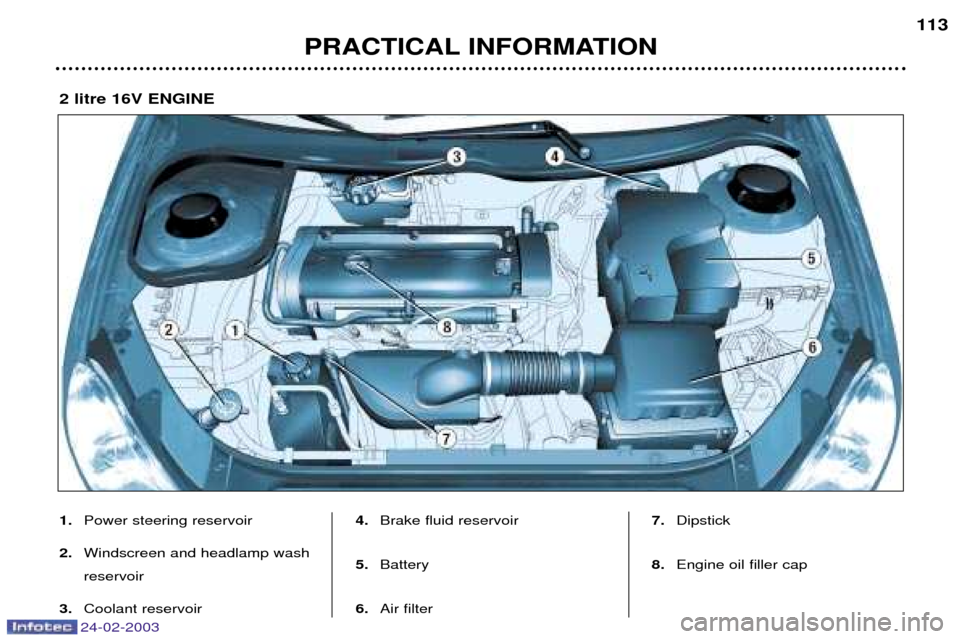
24-02-2003
PRACTICAL INFORMATION113
1.
Power steering reservoir
2. Windscreen and headlamp wash reservoir
3. Coolant reservoir 4.
Brake fluid reservoir
5. Battery
6. Air filter 7.
Dipstick
8. Engine oil filler cap
2 litre 16V ENGINE
Page 119 of 156
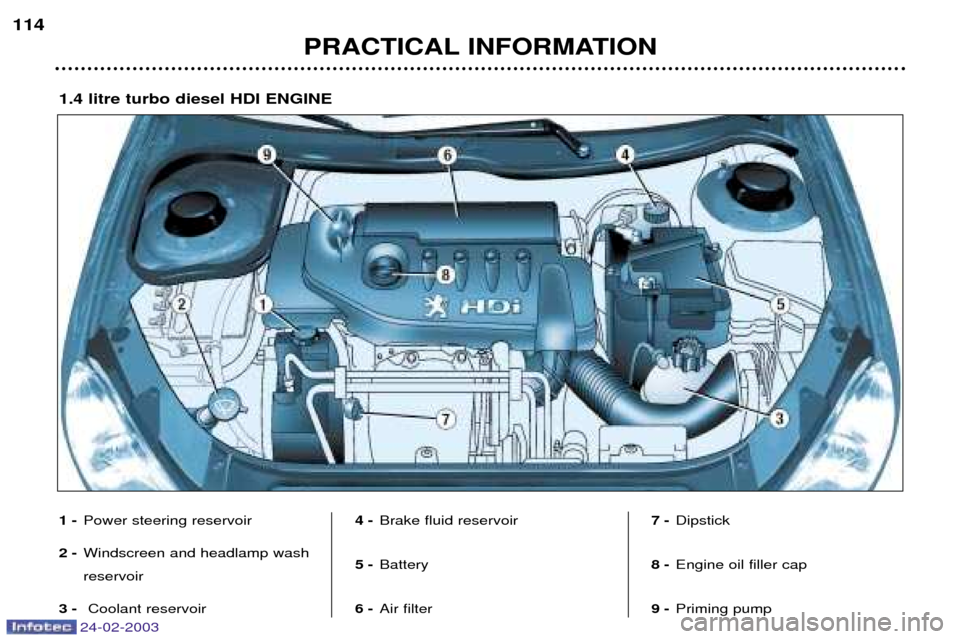
24-02-2003
PRACTICAL INFORMATION
114
1-
Power steering reservoir
2- Windscreen and headlamp wash reservoir
3- Coolant reservoir 4-
Brake fluid reservoir
5- Battery
6- Air filter 7-
Dipstick
8- Engine oil filler cap
9- Priming pump
1.4 litre turbo diesel HDI ENGINE
Page 120 of 156
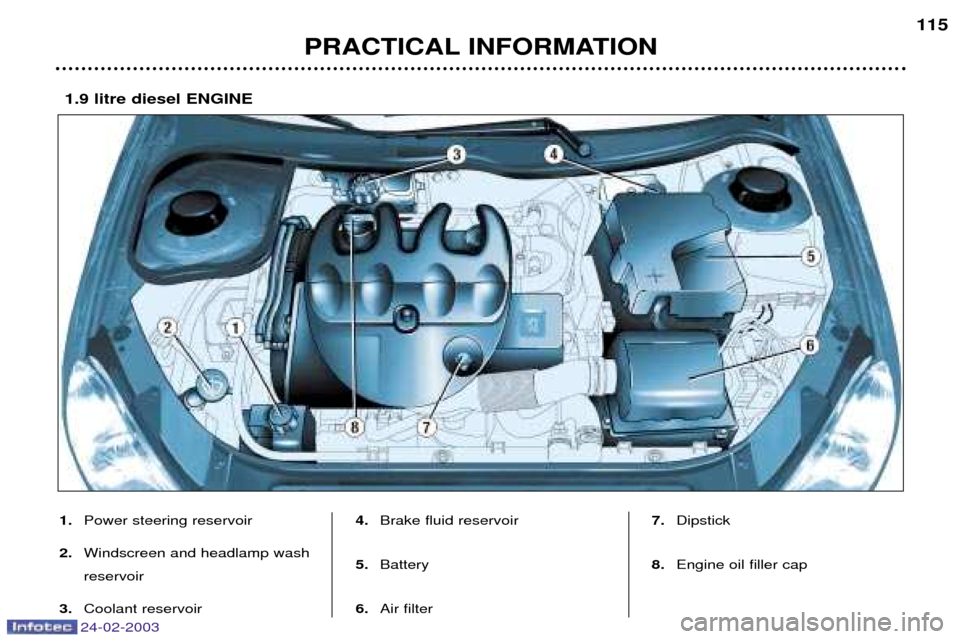
24-02-2003
PRACTICAL INFORMATION115
1.
Power steering reservoir
2. Windscreen and headlamp wash reservoir
3. Coolant reservoir 4.
Brake fluid reservoir
5. Battery
6. Air filter 7.
Dipstick
8. Engine oil filler cap
1.9 litre diesel ENGINE
Page 121 of 156
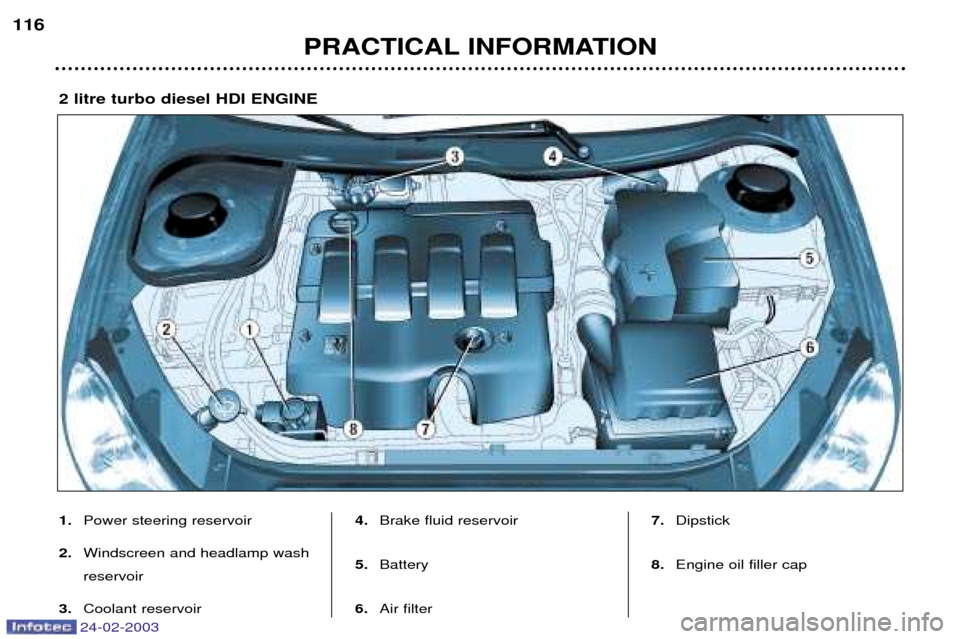
24-02-2003
PRACTICAL INFORMATION
116
1.
Power steering reservoir
2. Windscreen and headlamp wash reservoir
3. Coolant reservoir 4.
Brake fluid reservoir
5. Battery
6. Air filter 7.
Dipstick
8. Engine oil filler cap
2 litre turbo diesel HDI ENGINE
Page 123 of 156
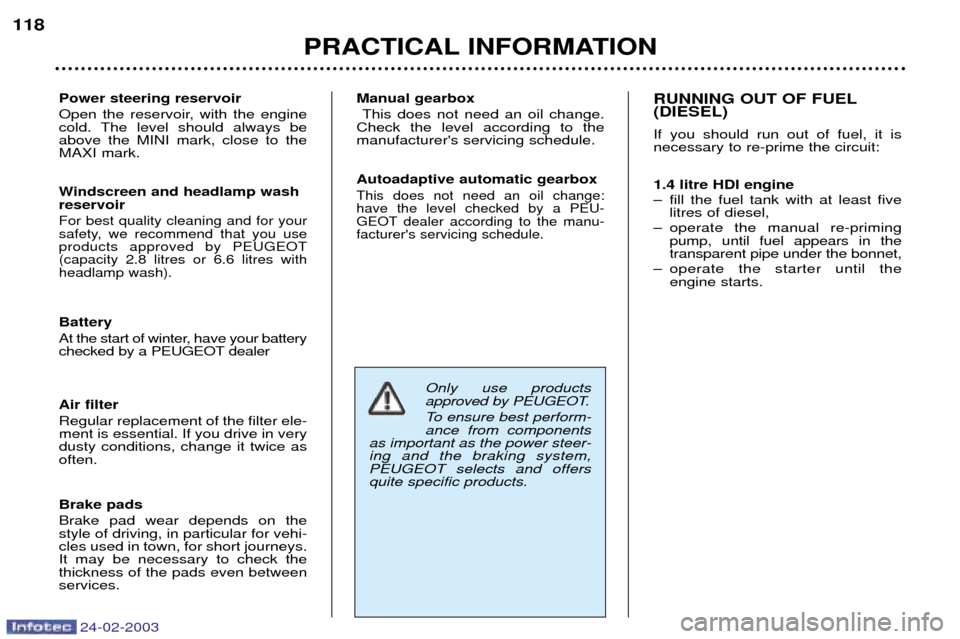
24-02-2003
PRACTICAL INFORMATION
118
Power steering reservoir
Open the reservoir, with the engine
cold. The level should always beabove the MINI mark, close to theMAXI mark. Manual gearbox
This does not need an oil change.
Check the level according to themanufacturer's servicing schedule.
Windscreen and headlamp washreservoir
For best quality cleaning and for your
safety, we recommend that you useproducts approved by PEUGEOT(capacity 2.8 litres or 6.6 litres withheadlamp wash).
Air filter Regular replacement of the filter ele- ment is essential. If you drive in verydusty conditions, change it twice asoften.
Battery
At the start of winter, have your battery
checked by a PEUGEOT dealer Brake pads Brake pad wear depends on the style of driving, in particular for vehi-cles used in town, for short journeys.It may be necessary to check thethickness of the pads even betweenservices. Autoadaptive automatic gearbox
This does not need an oil change:have the level checked by a PEU-
GEOT dealer according to the manu-facturer's servicing schedule.
Only use products
approved by PEUGEOT.
To ensure best perform- ance from components
as important as the power steer-ing and the braking system, PEUGEOT selects and offersquite specific products.
RUNNING OUT OF FUEL (DIESEL) If you should run out of fuel, it is necessary to re-prime the circuit: 1.4 litre HDI engine
Ð fill the fuel tank with at least five litres of diesel,
Ð operate the manual re-priming pump, until fuel appears in the transparent pipe under the bonnet,
Ð operate the starter until the engine starts.
Page 124 of 156
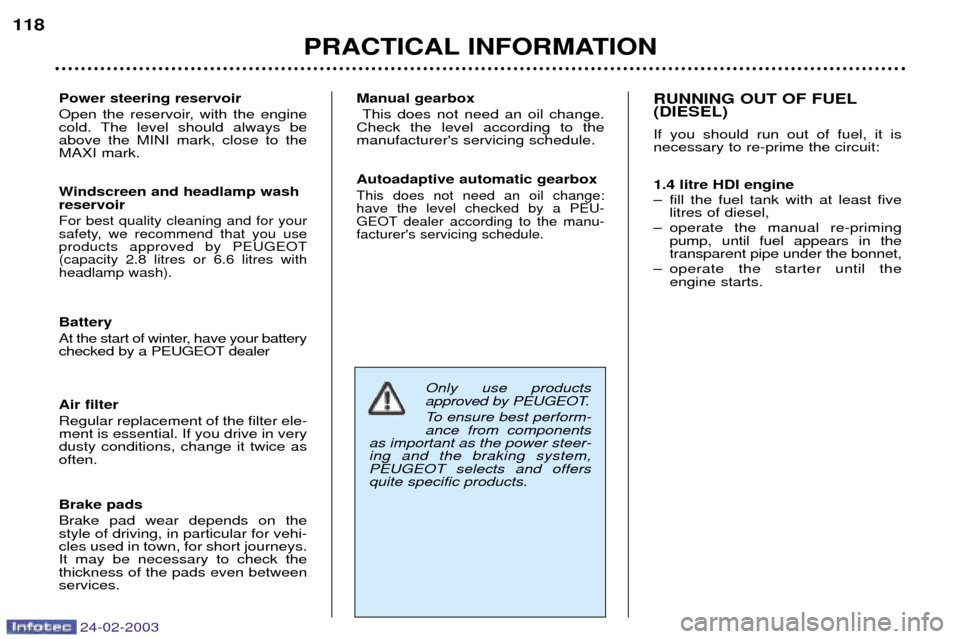
24-02-2003
PRACTICAL INFORMATION
118
Power steering reservoir
Open the reservoir, with the engine
cold. The level should always beabove the MINI mark, close to theMAXI mark. Manual gearbox
This does not need an oil change.
Check the level according to themanufacturer's servicing schedule.
Windscreen and headlamp washreservoir
For best quality cleaning and for your
safety, we recommend that you useproducts approved by PEUGEOT(capacity 2.8 litres or 6.6 litres withheadlamp wash).
Air filter Regular replacement of the filter ele- ment is essential. If you drive in verydusty conditions, change it twice asoften.
Battery
At the start of winter, have your battery
checked by a PEUGEOT dealer Brake pads Brake pad wear depends on the style of driving, in particular for vehi-cles used in town, for short journeys.It may be necessary to check thethickness of the pads even betweenservices. Autoadaptive automatic gearbox
This does not need an oil change:have the level checked by a PEU-
GEOT dealer according to the manu-facturer's servicing schedule.
Only use products
approved by PEUGEOT.
To ensure best perform- ance from components
as important as the power steer-ing and the braking system, PEUGEOT selects and offersquite specific products.
RUNNING OUT OF FUEL (DIESEL) If you should run out of fuel, it is necessary to re-prime the circuit: 1.4 litre HDI engine
Ð fill the fuel tank with at least five litres of diesel,
Ð operate the manual re-priming pump, until fuel appears in the transparent pipe under the bonnet,
Ð operate the starter until the engine starts.
Page 131 of 156
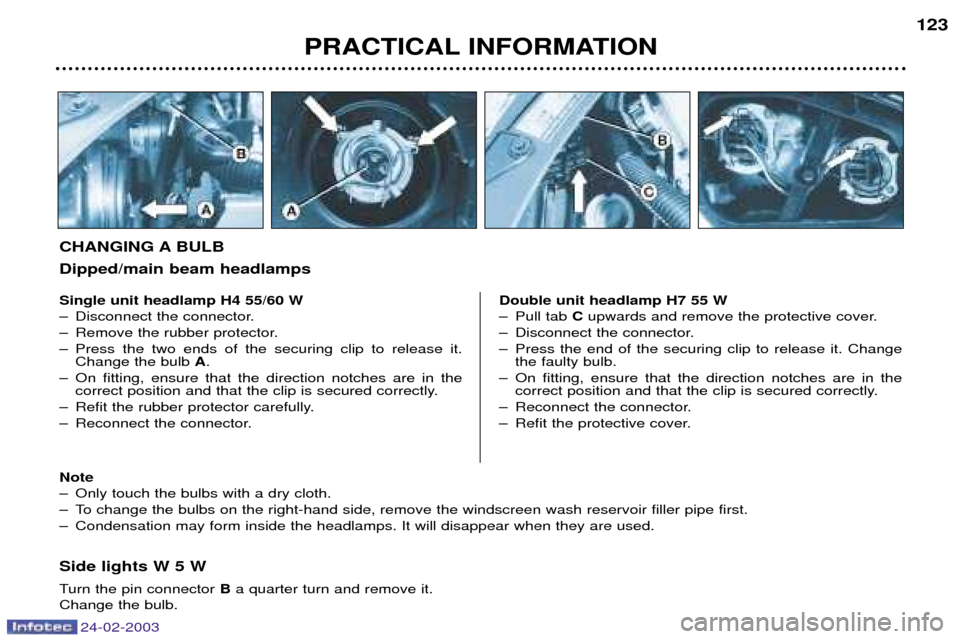
24-02-2003
PRACTICAL INFORMATION123
Side lights W 5 W
Turn the pin connector
Ba quarter turn and remove it.
Change the bulb.
Single unit headlamp H4 55/60 W
Ð Disconnect the connector.
Ð Remove the rubber protector.
Ð Press the two ends of the securing clip to release it.
Change the bulb A.
Ð On fitting, ensure that the direction notches are in the correct position and that the clip is secured correctly.
Ð Refit the rubber protector carefully.
Ð Reconnect the connector. Double unit headlamp H7 55 W
Ð Pull tab
Cupwards and remove the protective cover.
Ð Disconnect the connector.
Ð Press the end of the securing clip to release it. Change the faulty bulb.
Ð On fitting, ensure that the direction notches are in the correct position and that the clip is secured correctly.
Ð Reconnect the connector.
Ð Refit the protective cover.
CHANGING A BULB Dipped/main beam headlamps
Note
Ð Only touch the bulbs with a dry cloth.
Ð To change the bulbs on the right-hand side, remove the windscreen wash reservoir filler pipe first.
Ð Condensation may form inside the headlamps. It will disappear when they are used.
Page 132 of 156
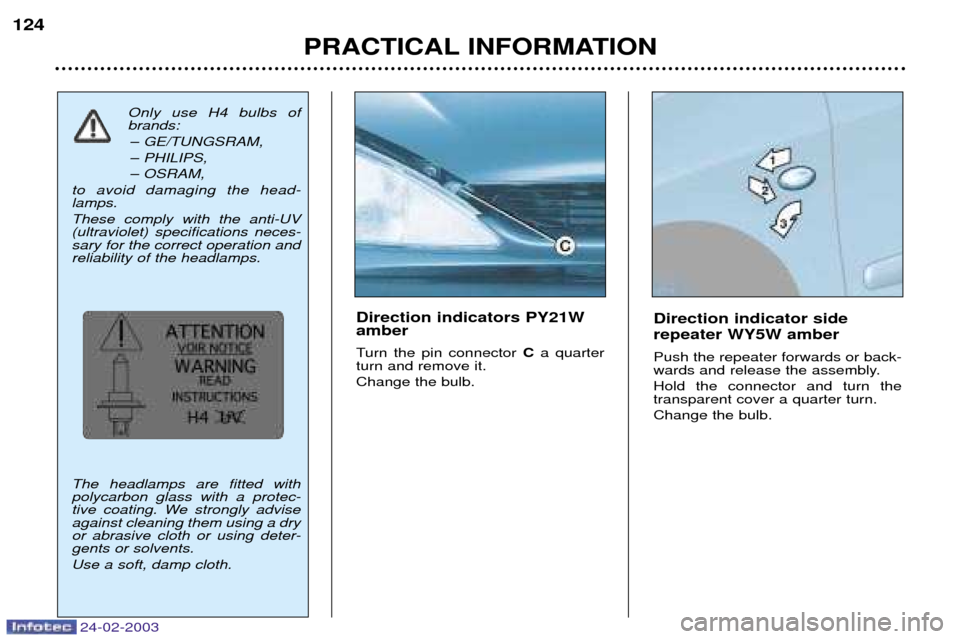
24-02-2003
PRACTICAL INFORMATION
124
Direction indicator side repeater WY5W amber Push the repeater forwards or back-
wards and release the assembly. Hold the connector and turn the transparent cover a quarter turn. Change the bulb.
Direction indicators PY21W amber
Turn the pin connector Ca quarter
turn and remove it. Change the bulb.
Only use H4 bulbs of brands:
Ð GE/TUNGSRAM,
Ð PHILIPS,
Ð OSRAM,
to avoid damaging the head- lamps. These comply with the anti-UV (ultraviolet) specifications neces-sary for the correct operation andreliability of the headlamps. The headlamps are fitted with polycarbon glass with a protec-
tive coating. We strongly adviseagainst cleaning them using a dryor abrasive cloth or using deter-gents or solvents. Use a soft, damp cloth.
Page 139 of 156
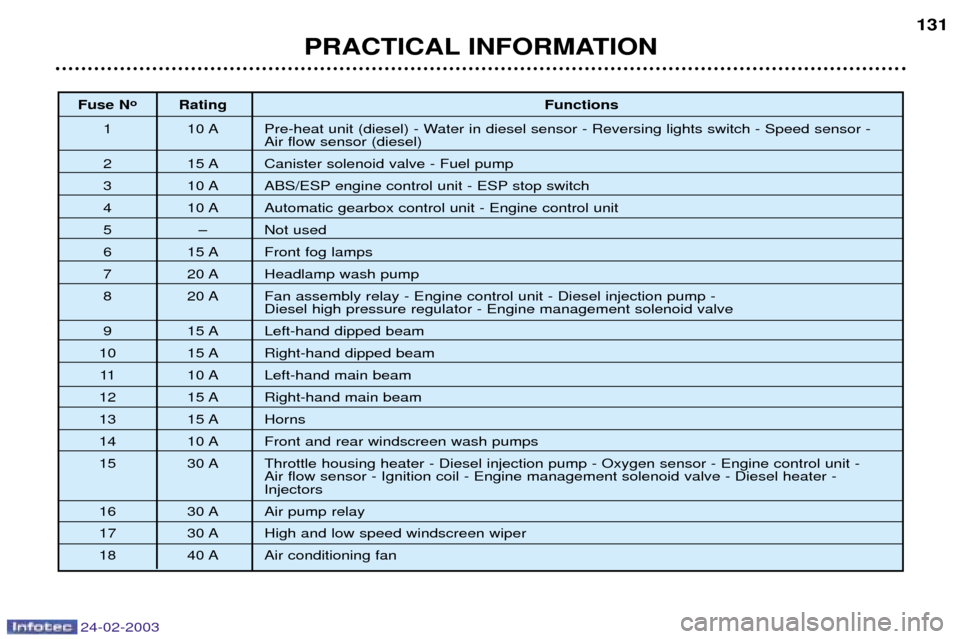
24-02-2003
PRACTICAL INFORMATION131
Fuse N
o
Rating Functions
1 10 A Pre-heat unit (diesel) - Water in diesel sensor - Reversing lights switch - Speed sensor - Air flow sensor (diesel)
2 15 A Canister solenoid valve - Fuel pump
3 10 A ABS/ESP engine control unit - ESP stop switch
4 10 A Automatic gearbox control unit - Engine control unit
5 Ð Not used
6 15 A Front fog lamps
7 20 A Headlamp wash pump
8 20 A Fan assembly relay - Engine control unit - Diesel injection pump - Diesel high pressure regulator - Engine management solenoid valve
9 15 A Left-hand dipped beam
10 15 A Right-hand dipped beam 11 10 A Left-hand main beam
12 15 A Right-hand main beam
13 15 A Horns
14 10 A Front and rear windscreen wash pumps
15 30 A Throttle housing heater - Diesel injection pump - Oxygen sensor - Engine control unit - Air flow sensor - Ignition coil - Engine management solenoid valve - Diesel heater - Injectors
16 30 A Air pump relay
17 30 A High and low speed windscreen wiper
18 40 A Air conditioning fan
Page 147 of 156
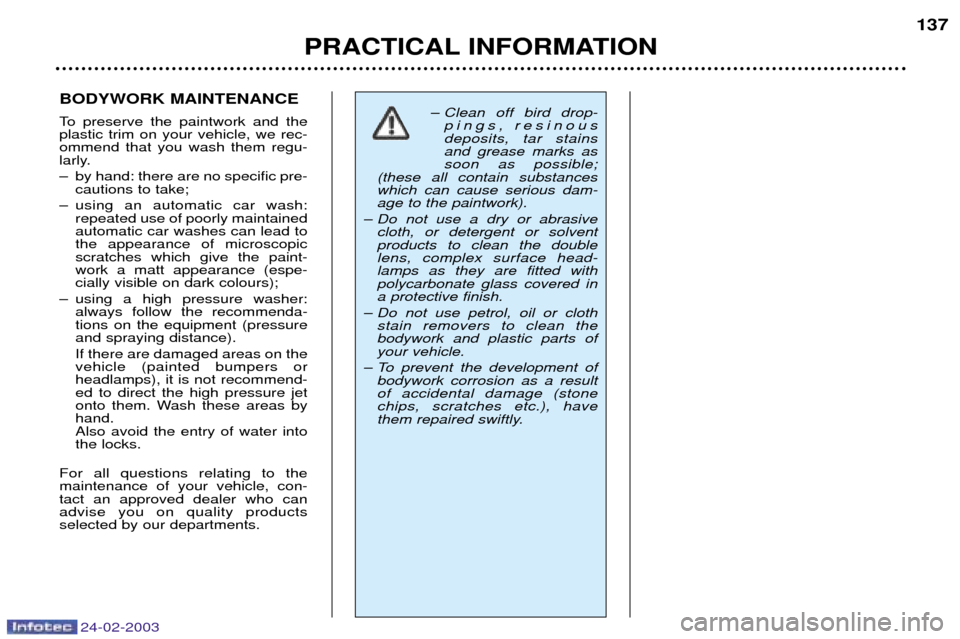
24-02-2003
PRACTICAL INFORMATION137
BODYWORK MAINTENANCE
To preserve the paintwork and the plastic trim on your vehicle, we rec-ommend that you wash them regu-
larly.
Ð by hand: there are no specific pre- cautions to take;
Ð using an automatic car wash: repeated use of poorly maintained automatic car washes can lead tothe appearance of microscopicscratches which give the paint-work a matt appearance (espe-cially visible on dark colours);
Ð using a high pressure washer: always follow the recommenda-tions on the equipment (pressureand spraying distance). If there are damaged areas on the vehicle (painted bumpers orheadlamps), it is not recommend-ed to direct the high pressure jet
onto them. Wash these areas byhand.Also avoid the entry of water intothe locks.
For all questions relating to themaintenance of your vehicle, con-tact an approved dealer who canadvise you on quality productsselected by our departments.
Ð Clean off bird drop- pings, resinous deposits, tar stainsand grease marks assoon as possible;
(these all contain substanceswhich can cause serious dam-age to the paintwork).
Ð Do not use a dry or abrasive cloth, or detergent or solventproducts to clean the doublelens, complex surface head-lamps as they are fitted withpolycarbonate glass covered ina protective finish.
Ð Do not use petrol, oil or cloth stain removers to clean thebodywork and plastic parts ofyour vehicle.
Ð To prevent the development of bodywork corrosion as a resultof accidental damage (stonechips, scratches etc.), have
them repaired swiftly.